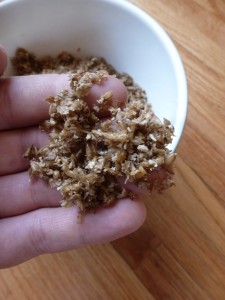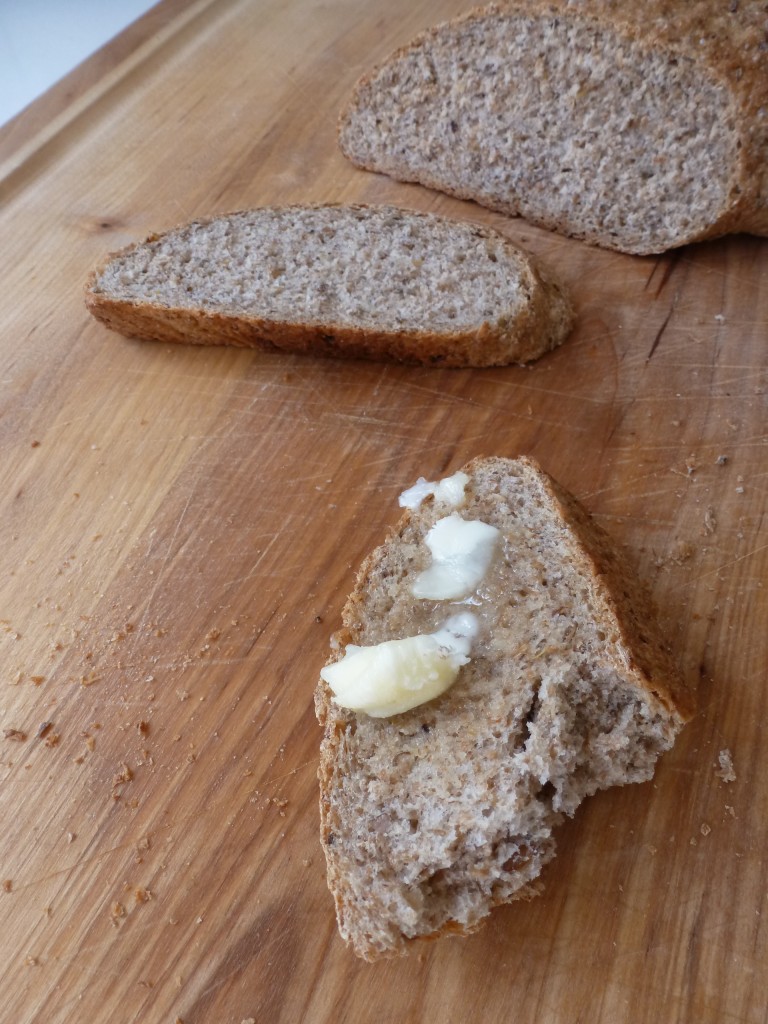 I’ve been doing some all-grain brewing this spring. After the mashing process the malt has given up all its caramel earthiness to the wort, and you are left with several pounds of spent grain, or draff.
I’ve been doing some all-grain brewing this spring. After the mashing process the malt has given up all its caramel earthiness to the wort, and you are left with several pounds of spent grain, or draff.
There are lots of ways to use this stuff up. Commercial breweries commonly sell or give draff to farmers as livestock feed. It can also be composted so long as you have lots of other, greener compostable material to balance out the mixture.
Draff is also commonly baked into bread. Realistically the home brewer will not be able to bake enough bread to use all of the spent grain – the bulk of mine still ends up in the compost heap – but it’s a tasty way to lengthen your enjoyment of the barley malt.
There are tons of recipes for spent grain bread online, often under the German name Biertreberbrot. These recipes are all clearly made for brewers, not bakers: they use inconsistent volumetric measures, and forgo flavour- and texture-enhancing pre-ferments. Below is my first attempt at a serious recipe for draff bread. Basically I’ve replaced the soaker from my favourite whole-grain bread recipe (from The Bread Baker’s Apprentice) with the spent grain.
Vocabulary Break: soaker. Many bread recipes that use whole or mostly-whole grains like rolled oats or cracked rye will have you soak the grains in a bit of water overnight. This way when the grains are mixed with the flour and water that make up the bulk of the dough, they won’t suck up all the water and prevent proper hydration, gelation, and gluten development.
Draff is already well-steeped: during mashing it sits in very hot water for about ninety minutes. For this reason we are able to simply substitute the draff for the grain soaker in a conventional whole-grain bread recipe. Spent grain is more woody that most whole grains, so I slightly decreased the weight of draff from the conventional soaker.
This is a tasty bread when made right. The malt flavour of the grain is very faint (hopefully all the malt flavour is in the wort!) but the hulls give the bread an interesting, subtle prickliness. A new brewing tradition in my home.

Draff Bread
Pre-Ferment
- 6.75 oz high-protein whole-wheat flour
- 1/4 tsp instant yeast
- 6 oz water
“Soaker”
- 8 oz spent grains, well-drained
Dough
- 10 oz high-protein whole-wheat flour
- 0.33 oz kosher salt
- 1 tsp instant yeast
- 1.5 oz honey
- 0.5 oz vegetable oil
- 1 large egg, lightly beaten
Procedure
- The day before making the bread, combine the ingredients for the pre-ferment. Stir until just combined. Cover with plastic wrap and leave at room temperature to ferment 2 to 4 hours. Transfer to the fridge and store overnight.
- Combine the flour, salt, and yeast for the dough. Add the pre-ferment, the spent grain, as well as the honey, oil, and egg. Stir to combine. Knead by hand until a firm, tacky dough forms, roughly 15 minutes.
- Lightly oil the inside of a bowl. Add the dough. Cover and ferment at room temperature until the dough has doubled in volume, about 2 hours.
- Divide the dough in two and shape as desired. This makes a good Pullman-style loaf, or it can be shaped into a free-standing bâtard. Proof at room temperature until the dough has nearly doubled, roughly 90 minutes. (See this post for suggestions on proofing bread at home.)
- Heat oven to 350°F.
- Bake bread for 30 minutes. Rotate 180° and bake until done, roughly another 20 minutes. The loaf should sound hollow when thumped on the bottom. If you’ve used pans, remove the bread immediately and cool on a wire rack.
